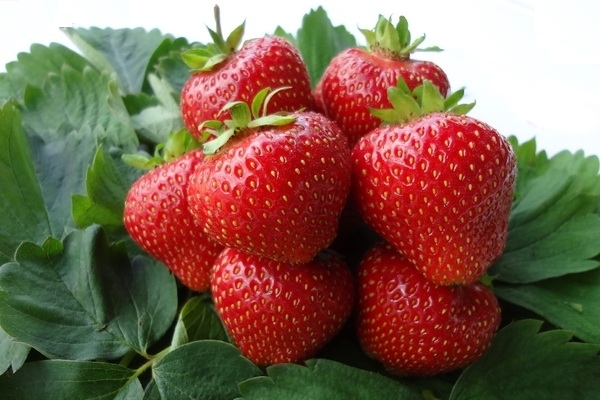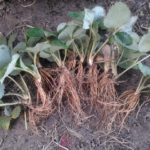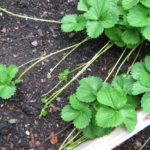Garden strawberry varieties Kimberley is very popular among gardeners. This is due to the fact that it does not require long-term attention to itself and brings an early harvest of juicy and sweet berries that can please with their excellent taste at the end of May.
Table of contents
Strawberry Kimberly Description
Let's start with a description of the variety. Kimberley Strawberry was bred in Holland by crossing varieties such as Chandler and Gorella.The bushes of this plant are quite small, squat, but at the same time very powerful and resistant. The leaves are medium in size, rounded and with a glossy, smooth surface. Fruits are strong, able to withstand the weight of the berries, while not leaning to the ground.
Fruiting Kimberley strawberries begins in late May - early June and lasts only 15-20 days, but even for this short period, from one bush can be collected from 1.5 to 2 kilograms of ripe berries.
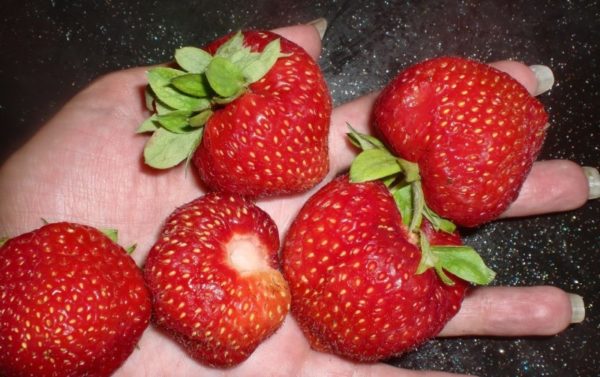
Quite large fruits, weighing 50-60 grams, are painted in bright red color and have a cone-shaped shape, which resembles hearts from a distance. To your taste berries are very juicy and sweet. This variety is characterized by the presence of light notes of caramel on the palate.
It is also worth noting that there are no empty cavities inside the fruit, due to which their shelf life and transportability increase.
Natural growth region
Kimberley garden strawberries are best suited for growing in regions with a warm and mild climate, but due to good frost resistance, this variety can also be grown in the central region of Russia.
In this case, it should be borne in mind that the plant will need additional shelter for the winter period and timely protection from return frost.
The advantages and disadvantages of the variety
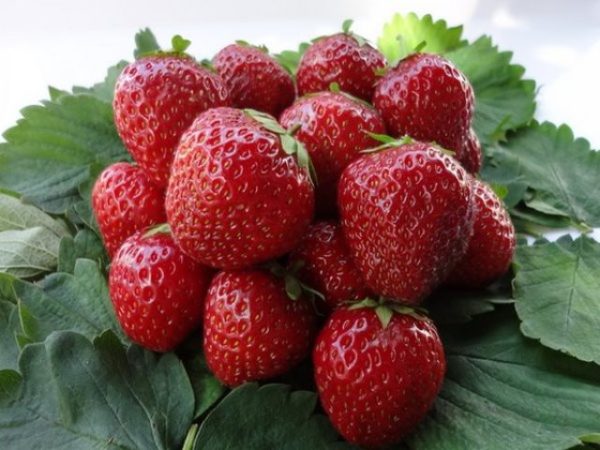
Grade advantages:
- Unusual, caramel flavor of the berries;
- Attractive appearance of the fruit;
- Good frost resistance, allowing to grow Kimberley in areas with cold and changeable climate;
- Strong and resistant peduncles;
- Early term fruiting;
- High yield;
- Berries are suitable for transportation over long distances;
- The variety is resistant to a large list of diseases.
Disadvantages:
- Kimberley variety strawberries do not tolerate drought and can quickly die without timely watering;
- Fruiting lasts only 2-3 weeks;
- Weak immunity to pests and insects.
Planting and plant care
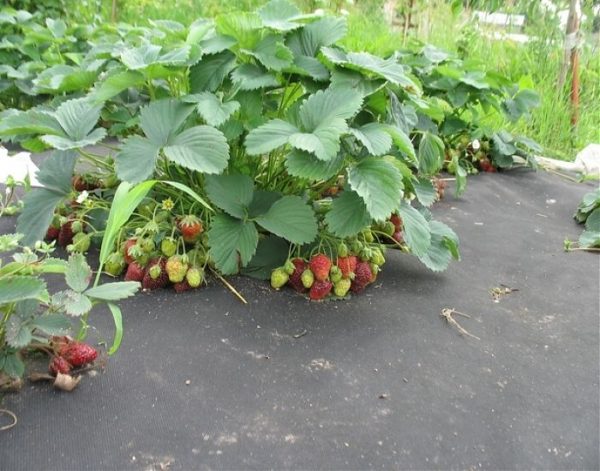
In order to get a rich harvest in the first place you need to properly plant garden strawberries. These works are recommended to perform in early April or early September. For strawberries choose sunny areas, protected from drafts and gusting wind.A suitable place is weeded and cleaned of stones, after which the following fertilizers are applied to 1 square meter:
- 6-8 kilograms of humus or rotted manure;
- 30 grams of wood ash;
- 50 grams of superphosphate.
After 7-14 days, after fertilizing a little brew, you can begin to perform basic work:
- To start digging shallow wells, which should be located at a distance of 60-80 centimeters from each other;
- Then the bottom of the hole is poured abundantly with water and a small mound is formed there;
- A small bush is placed on the resulting mound, straightened and instilled in such a way that the central kidney remains outside.
At the end of all the work the plant must be watered and mulched with improvised materials.
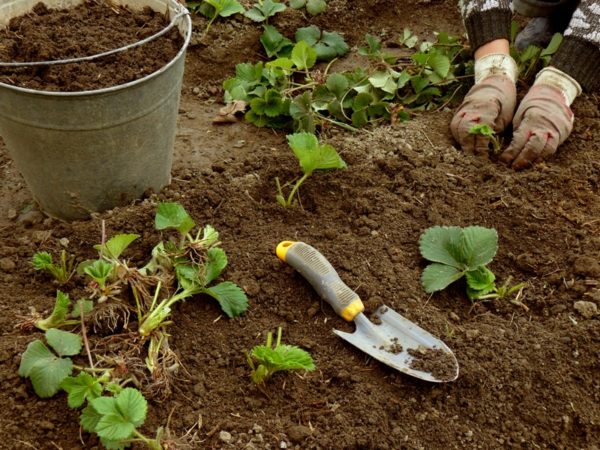
Planting care
Garden strawberries Kimberly loves moistureTherefore, in the absence of watering, the bushes can start to wither and die very quickly. Immediately after planting, the plant is watered daily, using a small amount of water.Once the strawberries are stronger, watering is carried out once a week, but on dry and hot days the amount of moisture applied must be increased to avoid drying out of the soil.
For strawberry it is very important to loosen and remove weeds in a timely manner. Another useful procedure will be mulching, with which you can retain moisture in the soil, slow the growth of weeds and protect the plant from pests. As mulch, you can use dry foliage, sawdust, pine needles, etc.
Kimberley is very responsive to fertilizing. Experienced gardeners recommend using the following scheme:
| In early spring, until the formation of new leaves | 500 milliliters of a solution prepared from 1 tablespoon of urea, 1 tablespoon of sodium humate and 10 liters of water are poured under each bush. |
| Before flowering, immediately after the appearance of the first leaves | · 500 milliliters of a solution of nitroammofoski is poured under the root, 1 tablespoon of which is diluted in 10 liters of water;
· The green part of the plant is sprayed with urea. |
| During the formation of the fruit | 2 tablespoons of ash are diluted in 1 liter of boiling water and the solution is infused for 24 hours, after which garden strawberries are watered. |
| Preparing for the winter | · In the middle of September a bucket of rotted mullein and 100 grams of ash are poured under each bush;
· After 10-14 days strawberries are watered with a solution prepared from 1 liter of water, 2 tablespoons of nitrophoska, 1 tablespoon of kale sulphate and 200 grams of ash. |
In order to prepare the strawberries for the winter, it is necessary to lay a mullein or humus under the bushes, and cover them with spruce fir branches or nonwoven material from above.
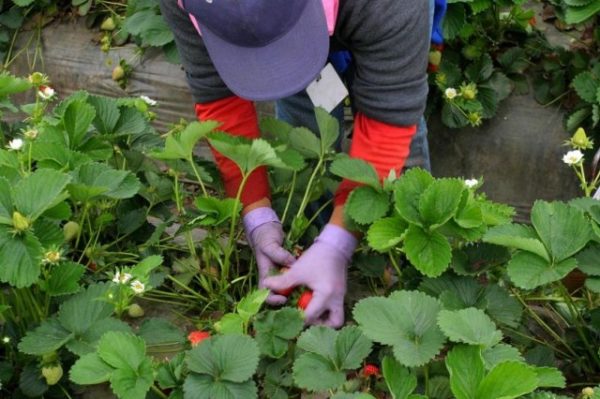
Breeding methods
There are several ways to grow strawberries.
With the help of seeds
Seedlings begin to sow in late winter-early spring:
- The soil consisting of 3 parts of sand and 5 parts of humus is placed in a container, moistened and spread out on top of the seeds, slightly digging them into the soil;
- Then the container is closed with a film and placed in a room with an air temperature of 20 degrees;
- Seedlings air out and moisten the soil daily;
- After 10-14 days, the first shoots should appear, after which the film can be removed;
- With the advent of several true leaves, the seedlings are moved to the open ground.
Antennae
For this type of breeding, adults, 2-year-old plants, which are left with developed and powerful mustache, are well suited. The sockets formed on them are pressed into the ground and watered abundantly, after which they are looked after as a seedling. After the central bud is formed, the daughter bush can be separated from the mother plant and transplanted to a permanent place.
Dividing bush
A healthy shrub is dug out of the ground and divided into several parts, with a central kidney must be present on each of which. The resulting seedlings are placed in the wells and continue to grow as individual plants.
- Division bush
- Growing from seed
- Antennae
Features of fruiting
Like many other varieties, the Kimberley strawberry has a number of distinctive features that must be considered when it is grown:
- Despite the fact that the variety is already considered early and so it is possible to get ripe berries in early June, this period can be significantly reduced if you grow bushes in special tunnels;
- For improvement of fructification it is recommended to remove the antennae;
- Ripe fruits are harvested only in dry weather in the early morning or in the evening. In this case, the berries remain fresh longer.
Diseases and pests
Kimberly's garden strawberry has good resistance to various diseases., but you can still find a nematode or gray rot on it.
- In order to get rid of nematodes, it is necessary to cut off the affected parts of the plant as quickly as possible and process the bush with a one-percent solution of Brodsky liquid or Topaz;
- Gray rot can be cured by spraying strawberries with iodine solution prepared in a ratio of 1-10.
Unfortunately, this variety is often affected by pests and to get rid of them, you must follow the following instructions:
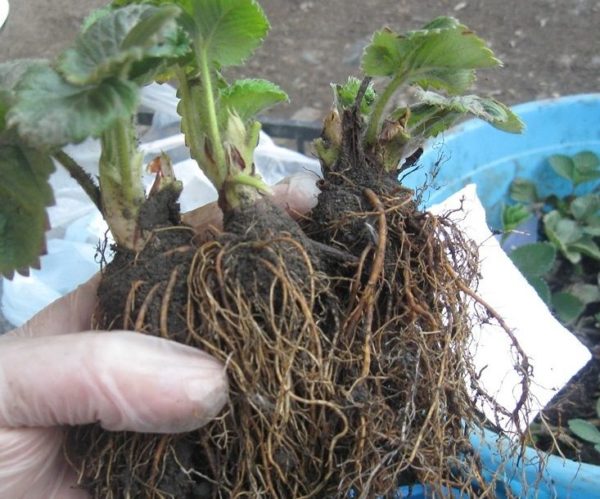
- Large insects that are visible to the naked eye are harvested by hand;
- 500 grams of dandelions are placed in a bucket of warm water and left there for 3 hours, the resulting solution is sprayed with strawberries;
- The head of garlic is crushed and poured with 3 liters of water and then infused for 1 week. Such an infusion will help to effectively get rid of pests;
- If the methods of traditional medicine are powerless, you will have to use special preparations, such as "Fitoverm" or "Aktellik".
The most important measure of prevention against insects and diseases will be proper care, which includes timely watering and feeding, removal of weeds and affected parts of the plant.
Kimberley strawberries can please everyone with a delicious and juicy harvest of early berries. In addition, such a shrub does not require complex care and tolerates a variety of weather conditions.
